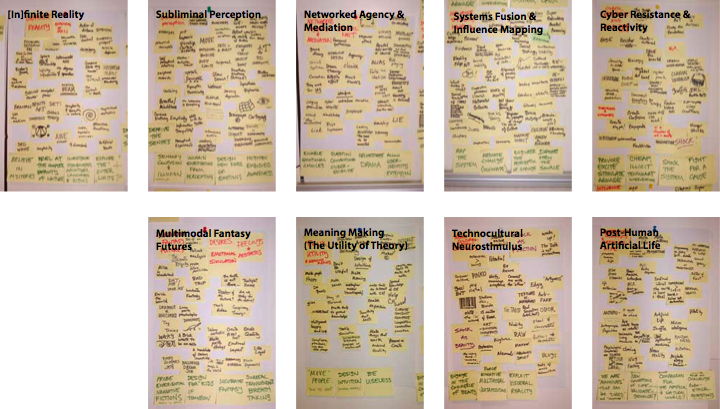  |
Observations
The Observations task-module of the Ambithink interface will allow users to upload things they see in the world, and synthesize them to develop areas of opportunity for idea brainstorming. This part of the interface has not been prototyped here yet. It will include ways to add, edit, and sort clouds of observed data (including photographs, links to websites, etc.). Many users may not be interested in this phase, but it is potentially the most important for strategic design. Observations could be general (based on personal interests), or tagged as part of a specific project or area of need. For demonstration purposes I have performed this process using postit notes.
Example: Observed Trends in Technocultural Awareness
As initial research for my thesis development I was interested in developing innovative perceptual robotic and virtual reality experiences. For three weeks I took extensive notes on this topic everywhere I went, focusing on the following areas of interest: intriguing concepts and discussion topics; university seminars and activities; personal fascinations, brainstorms and streams of thought; advertisements, publicity, films, movies, magazines, online experiences and other forms of mass media content; repeated conversations with interested professors, colleagues and friends; and observations of things that people such as myself seemed to enjoy doing. These notes were placed unorganized on boards, and then synthesized into groups based on similarity.
Nine clusters of trends were identified, representing a cross-section of my area of interest for this particular project. These trends are important because they represent areas of opportunity for innovation. In the next phase, for example, brainstorm topics will be identified to help generate concepts based on these opportunities.

The finished Ambithink system would help me synthesize all of this information and write concise descriptions of each trend area to help me keep track of what I have observed. The overview descriptions of these trends I came up with are provided here, for example. From each of these trend areas, brainstorm topics were generated to help me develop innovative ideas that responded specificially to these areas of need.
For example, in the case of Multimodal Fantasy Futures, the following questions were identified: "How could perceptual robotic technologies be used to..." probe experiential narrative fictions?; design for the kids of tomorrow?; incubate fantasy?; and create surreal, transcendent, breathtaking experiences? A second round of synthesis grouped these 52 key questions into clusters indicating seven major areas of action. Brainstorming ideas based on these questions is performed in the following task-module (Opportunities).
The brainstorm topics identified at this stage of the process were: "How could perceptual robotic technologies be used to..."
i) Explore the outer limits
Speak with aliens
Believe in mysteries
Conjure new forms of life
Create surreal, transcendent, breathtaking experiences
Design new kinds of emotions
Revel at the complex beauty of nature
Evoke compassion for the artificial and natural world
Fall in love
ii) Engineer the perception of change
Innovate
Mediate creative change
Embody brand experience
Engage in the commerce of beauty
Make money
Design human intuition (universal heuristics)
Perform cheap, illicit, technoart interventions
Shock the system
iii) Investigate consciousness
Confuse and elude the senses
Unchain expectations from perceptions
Deprive the senses
Experience mindfulness
Heighten embodied awareness
Map awareness
Distill the essence of being
iv) Make meaning
Map systems of influence
Open the source
Raise and challenge ethical questions, beliefs & concerns
Investigate symbologies, archetypes, languages and signs
Be useless
Incubate fantasy
Touch the heart
v) Pioneer multimodal interactivity paradigms
Allow user-identity extension (and play)
Orchestrate drama
Force evocative multimodal juxtapositions
Probe experiential narrative fictions
Exploit visceral reality
Seamlessly interact with the virtual
Question conventional cyber-etiquette
Provoke, excite, stimulate and arouse
vi) Save the world
Do good
Fight for a cause
Stop global warming
Spread wellness
Empower others
Enable emotional choices
Express individual and cultural identity
Design for the kids of tomorrow
vii) Be bad*
Kill eachother
Expand our ego
Eliminate the soul
Extinguish humanity
Do evil
*note: The intent of this category is to explore and understand the ethical issues involved with the design and development of new multimodal experiences, not necessarily to develop them (unless they so extremely dangerous that not developing them first would be dangerous).

|

